|
Home \ Introduction
Introduction
The SMA project in TaiwanThe SMA Project was originally conceived at the SAO in 1983. While the initial concept for the SMA was six 6~m antennas, in 1996, the ASIAA joined the SMA project by agreeing to add two more antennas and all the associated electronics, including a doubling of the correlator and additional receiver systems. The Academia Sinica founded the expansion of the SMA as the first astronomical project at the ASIAA. The additional two antennas increase the number of instantaneous baselines from 15 to 28, nearly doubling the mapping speed of the array. It is the first time for the ASIAA to construct submillimeter telescopes and receivers. A key for the institute to construct two antennas in Taiwan was to find expertise at industries. The Aeronautical Research Laboratory (ARL) was selected as a general contractor for the antenna construction because of their considerable experiences in high-precision assembly of jet airplanes. The mounts that support the antennas were constructed at the China Shipping Building Corporation (CSBC) because of its experiences in manufacturing and handling large metal parts for ships. Carbon fiber reinforced plastic tubes for the backup structures supporting the reflecting surface of each antenna were manufactured by NYTEX (currently GIGAN TEX), one of Taiwanese leading composites manufacture. In fact, tubes made in Taiwan are so good yet economical that they were also used in all the antennas constructed by the SAO. In order to develop and deliver receiver systems for two additional antennas, the ASIAA has established a laboratory for submillimeter receivers. In addition, the ASIAA has started collaborations with National Tsinghua University in Taiwan, Nobeyama Radio Observatory in Japan, and the Purple Mountain Observatory in China to produce SIS junctions for the SMA receiver system. By the end of 2003, all eight antennas of the array had been deployed on the top of Mauna Kea, and the SMA was formally dedicated on 2003 November 22. More details of the SMA are found in Ho, Moran, & Lo (2004). History
|
>> INTERNAL DOCU | ASIAA



 The Submillimeter Array (SMA), constructed at the top of Mauna Kea in Hawaii as a collaborative project of the
The Submillimeter Array (SMA), constructed at the top of Mauna Kea in Hawaii as a collaborative project of the 